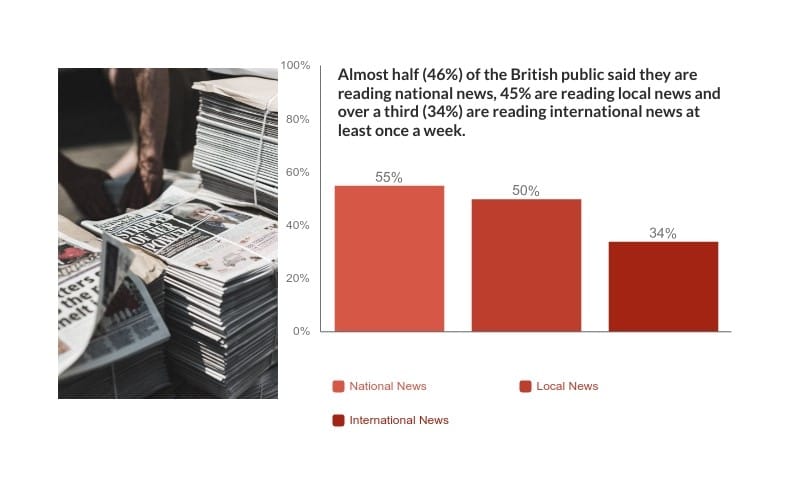
The spotlight is firmly on the media
Despite being well into the swing of lockdown, many are still coming to terms with or adjusting to the new normal. For a lot of companies in our industry, the new normal is adapting communications strategies and our new research has highlighted just how important this is.
We have been surveying Brits across the country on their media habits and have found that they are relying on journalism more now than ever.
All eyes are on the news
The top types of publications Brits are reading at least once a week are national news, local news, and international news. We’re seeing an increase as time goes on, indeed, in the space of just a week these have increased quite substantially:

o National news 46% to 52%
o Local news 45% to 49%
o International news 34% to 38%
For context, while 4% increase of those who are reading international news might not seem like much, this is the equivalent of over two million people.****
Interestingly, it’s the younger generation (16-24-year olds) in which we have seen a huge increase in numbers reading national news at least once a week: from 30% to 45%.
In addition, from the respondents who are reading publications at least once a week, over half said they are reading these more than they usually do. Again, comparing week-on-week, this increased from 48% to 56%.
In our latest research, it shows that almost three quarters (73%) of 16-24-year olds* surveyed are reading these publications more than they usually do. While 2 in 5 (40%) respondents* aged 55+ said the same, an increase from the previous week.
Outside of COVID-19, why are people reading the news more?
Unsurprisingly, the main reason people** are reading the news more is to keep up-to-date with the coronavirus virus situation, which came out top both times (77% in week one and 80% in week two).
The following reasons were the next most often cited by respondents** for reading more of these publications:
- Because they have more spare time (22%), in a week, this has almost doubled to 43%
- Because people are sharing more news stories with them (21%). However, this most-cited reason has changed in a week and is now because they want some good news (23%).
Looking at gender comparisons, it’s male respondents** that are reading publications more because they want some good news compared to female respondents (27% vs 19%).
Why are people reading the news less?
Some respondents*** are reading publications less than usual though, and the top three reasons most often cited are:
- Because the news is so negative (30%) after a week this has decreased to 23%
- Because the news makes them anxious (27%), after a week this is now the number one reason and has increased to 32%
- Because they find the news scary (24%), after a week this has decreased slightly to 22%
So, what content do people want?
While most news outlets are balancing positive stories with news that reminds us of the gravity of the situation, we explored the type of content Brits wanted to see. Once again, we have seen an increase in the statistics. The top 3 types of content most often cited by respondents in the two weeks are:
- Heart-warming stories about human kindness (37%), after a week this has increased to 45%
- More information about the coronavirus (34%), after a week this has increased to 41%
- Stories backed up with data (34%), after a week this has increased to 36%
It’s clear then, that the spotlight is on the media industry and that the expectations of Brits are shifting week-on-week. This makes the challenges faced by our industry all the more difficult to navigate and only through understanding the desires of the nation can we expect to do so effectively.
From the data we can see that engagement across the board has risen, meaning that more and more people are turning to the media for updates, in particular the young generation, though this increase is consistent throughout the whole of the population.
Appetites are also shifting, with a larger percentage of the population wanting light-hearted news stories, albeit the desire for COVID-19 related information is also steadily on the rise. Interestingly, however, we have also seen a rise in people who are turning away from the news due to growing feelings of anxiety.
So the population has communicated mixed messages with us, there is no one-size-fits-all approach here, though there rarely is. All we can do is listen to the public, share those stories that will keep us safe and do our best to create meaningful, yet lighthearted discussion in these difficult times.
If you would like to see the results or speak to a member of the team about a research project, please email: [email protected] or if you would like to see our research into consumer perception of brands, please see here.
Notes:
*Respondents who are reading publications at least once a week
**Respondents who are reading publications at least once a week and reading currently more than they usually do
***Respondents who are reading publications at least once a week but reading currently less than they usually do
****calculated based on ONS figures (2017): 53,534,872*0.04 = 2,141,395
The first round of research was conducted by Censuswide, with a sample of 2,001 nationally representative respondents aged 16+ in the UK between 20.03.2020 – 23.03.2020.
The second round of research was conducted by Censuswide, with a sample of 2,036 nationally representative respondents aged 16+ in the UK between 27.03.2020 – 30.03.2020.
